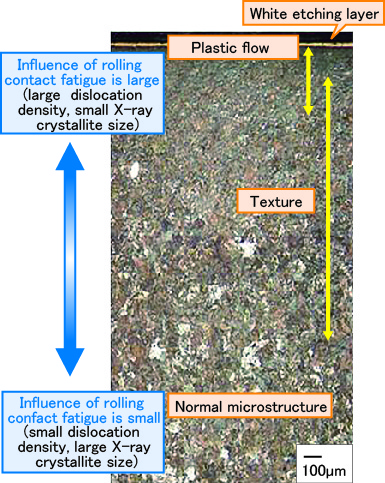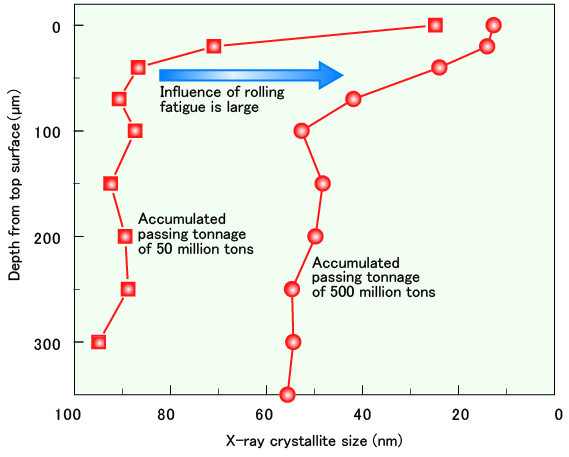5. Evaluation of the rolling contact fatigue layer formed on rails using X-ray Fourier analysis
- It is possible to quantify inside a rail from it surface, changes to its metallurgical microstructure due to rolling contact fatigue with indicators such as X-rayed crystallite size and dislocation density which increase in correlation with plastic strain.
- It is expected that this evaluation method will make it possible to determine more effective rail grinding and rail replacement maintenance work.
Constant rolling of wheels along the rail leads to surface rolling contact fatigue due to an accumulation of plastic strain causing plastic deformation, altering the surface microstructure from its normal state (Fig.1). Consequently, in order to be able to evaluate the state of rolling contact fatigue, an X-ray Fourier analysis method was proposed which uses diffracted wave characteristics obtained through X-ray examination (peak amplitude, strength and shape, etc.). This method can be used to quantify the plastic deformation in the microstructure.
The state of rolling contact fatigue of the rail using this method is evaluated on the basis of X-rayed crystallite size and dislocation density, which are strong indicators of rolling contact fatigue. X-ray crystallite size can determine the micronization of the microstructure which becomes finer as plastic strain grows. Dislocation density on the other hand shows the dispersal of the microstructure's micronization. As plastic strain increases, dislocation density also rises. X-ray Fourier analysis allows evaluation of the microstructure which changes under the influence of rolling contact fatigue, which causes dislocation density to fall while the X-ray crystallite size (Fig.1)increases. Furthermore, since it is known that the influence of rolling contact fatigue grows with rail use, through accumulated (passing) tonnage, etc., this method should make it easier to assess the state of rolling contact fatigue (Fig.2). The data which can be acquired through this method about the state of rolling contact fatigue can then be used to determine more appropriate rail grinding and rail replacement cycles.

Fig.1 Optical microstructure of rail with rolling contact fatigue
(accumulated passing tonnage of 500 million tons)
Fig.2 The state of rolling contact fatigue quantified
using X-ray Fourier analysis method